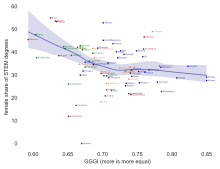
Back লিংগ-সমতা বিৰোধাভাস Assamese Paradoxa de la igualtat de gènere Catalan Ligestillingsparadokset Danish Paradox der Gleichberechtigung German Sukupuolten tasa-arvon paradoksi Finnish Paradoxe de l'égalité des sexes French Paradosso dell'uguaglianza di genere Italian Likestillingsparadokset NB Paradoxo da Igualdade de Gênero Portuguese Jämställdhetsparadoxen Swedish

| Part of a series on |
| Sex differences in humans |
|---|
 |
| Biology |
| Medicine and health |
| Neuroscience and psychology |
| Sociology and society |
The gender-equality paradox is the finding that various gender differences in personality and occupational choice are larger in more gender equal countries. Larger differences are found in Big Five personality traits, Dark Triad traits, self-esteem, depression, personal values, occupational and educational choices. This phenomenon is seemingly paradoxical because one would expect the differences to be reduced as countries become more gender egalitarian.[1] Such a paradox has been discussed by numerous studies ranging from science, mathematics, reading, personality traits, basic human values and vocational interests.
Various explanations for the paradox have been proposed. Some scholars suggest that more stereotypes and gendered expectations in more gender equal countries are responsible[2] and that women in less developed nations are more likely to choose STEM fields, based on the increased need for security and good pay.
The most prominent use of the term is in relation to the disputed claim that increased gender differences in participation in STEM careers arise in countries that have more gender equality,[3][4] based on a study in Psychological Science by Gijsbert Stoet and David C. Geary,[5] which received substantial coverage in non-academic media outlets.[6][7][8][9] However, separate Harvard researchers were unable to recreate the data reported in the study, and in December 2019, a correction was issued to the original paper.[10][11][12] The correction outlined that the authors had created a previously undisclosed and unvalidated method to measure "propensity" of women and men to attain a higher degree in STEM, as opposed to the originally claimed measurement of "women’s share of STEM degrees".[11][10][4] However, even incorporating the newly disclosed method, the investigating researchers could not recreate all the results presented.[4][12] A follow-up paper in Psychological Science by the researchers who discovered the discrepancy found conceptual and empirical problems with the gender-equality paradox in STEM hypothesis.[13][4] Another 2020 study did find evidence of the paradox in the pursuit of mathematical studies; however, they found that "the stereotype associating math to men is stronger in more egalitarian and developed countries" and could "entirely explain the gender-equality paradox".[14]
- ^ Fors Connolly, Filip; Goossen, Mikael; Hjerm, Mikael (2020-07-01). "Does Gender Equality Cause Gender Differences in Values? Reassessing the Gender-Equality-Personality Paradox". Sex Roles. 83 (1): 101–113. doi:10.1007/s11199-019-01097-x. ISSN 1573-2762.
- ^ Breda, Thomas; Jouini, Elyès; Napp, Clotilde; Thebault, Georgia (2020-12-08). "Gender stereotypes can explain the gender-equality paradox". Proceedings of the National Academy of Sciences. 117 (49): 31063–31069. Bibcode:2020PNAS..11731063B. doi:10.1073/pnas.2008704117. ISSN 0027-8424. PMC 7733804. PMID 33229558.
- ^ Khazan, Olga (2018-02-18). "The More Gender Equality, the Fewer Women in STEM". The Atlantic. Retrieved 2020-12-28.
- ^ a b c d Cite error: The named reference
:17was invoked but never defined (see the help page). - ^ Stoet, Gijsbert; Geary, David C. (14 February 2018), "The Gender-Equality Paradox in Science, Technology, Engineering, and Mathematics Education" (PDF), Psychological Science, 29 (4): 581–593, doi:10.1177/0956797617741719, PMID 29442575, S2CID 4874507
- ^ Cite error: The named reference
:12was invoked but never defined (see the help page). - ^ Cite error: The named reference
:13was invoked but never defined (see the help page). - ^ Cite error: The named reference
:14was invoked but never defined (see the help page). - ^ Cite error: The named reference
:15was invoked but never defined (see the help page). - ^ a b Cite error: The named reference
:0was invoked but never defined (see the help page). - ^ a b Cite error: The named reference
:7was invoked but never defined (see the help page). - ^ a b Cite error: The named reference
:18was invoked but never defined (see the help page). - ^ Cite error: The named reference
:19was invoked but never defined (see the help page). - ^ Cite error: The named reference
:30was invoked but never defined (see the help page).